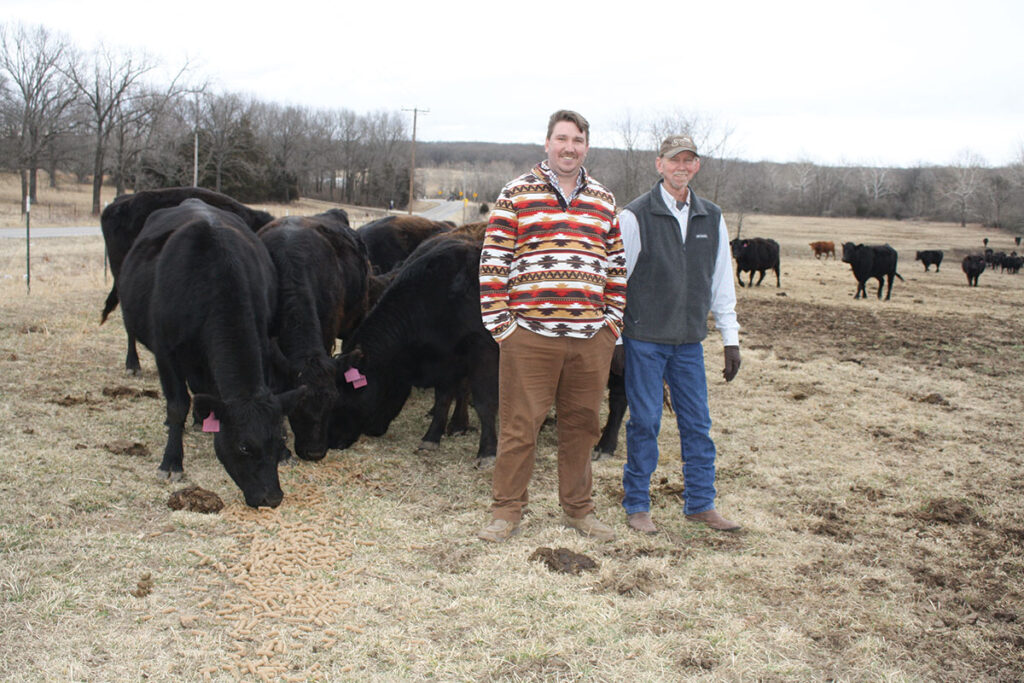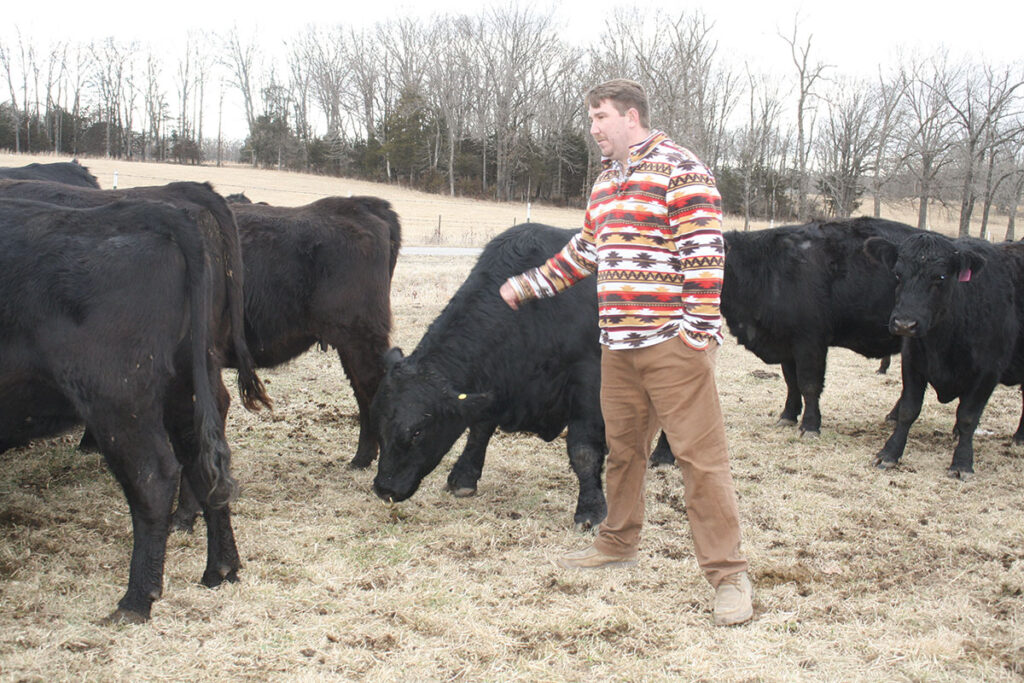
Chase Wilson and his father Kevin Wilson are part of the family-operated Route 66 Cattle Company. Chase credits Kevin with introducing him to the Limousin breed. Photo by Julie Turner-Crawford.
Route 66 Cattle Company laid the foundation for a registered Limousin herd in 2017
MARSHFIELD, MO. – When Kevin Wilson bought a Limousin bull in 1995 for his commercial herd, his son Chase was impressed with the newly-acquired sire’s offspring. Since that time, Limousin genetics have remained a part of the Wilson herd and in the forefront of Chase’s mind.
“I guess it gets into your blood,” Chase said. “When I started my own thing, we went to a registered Limmy sale in 2017 for one and come home with six. It’s been a blur since then. We have always had commercial cattle with Limmy bulls, but those were the first set of registered animals. Now, we have almost flipped entirely to a registered operation. We do keep some commercial cows are recips for the donor program.”
The herd has grown to 100 head of registered Limousin under the flag of Route 66 Cattle Company, which is a family partnership with Chase, his son Harlan Wilson, his parents, Kevin and Kay Wilson, Chase’s partner Karen Favor and her daughter Karlee Favor.
Moving from commercial to registered has been a transition, with family patriarch Kevin liking larger-framed cattle with high milk numbers, while Chase wants to trim them down a bit.
“He is going to like cows with the biggest calf in the pasture,” Chase said. “I like mine to have a sleek appearance and that long, extended front end.”
The primary focus of Route 66 Cattle Company is to produce males and females that go on to produce high-quality calves, be it for breeding stock or feeder calves.
“We are looking for some powerful, quality females and your traditional, stout Limousin bull,” Chase said. “We sell bulls locally through private treaty and some replacement heifers, but we are still going to have those animals that will go to the sale barn, which will help the registered side cash flow. At Dad’s place, it might be 80/20 commercial (cattle), then here it’s going to be the opposite. That might change one day because the industry is constantly evolving. You go back and look at old catalogs, and those cows don’t look anything like the ones now.
“I like the feed efficiency of Limmy cattle. The brokers are saying that’s the thing that you see when you look around at the feedlots, the bull that is crossing the best with all of these animals and that’s a Wulf (Cattle Company in Minnesota) Limmy bull that has been out there for three or four years. You hear Jackie Moore at Joplin Regional (Stockyards) talk about what he looks for in feeders, and that’s that Limmy-cross; those F1 calves.”
Chase added the development of LimFlex cattle, which are composites of Limousin and Angus, are just another added value to the breed.
“Being able to register those animals is pretty important, and I think lot of people are looking for that right now,” Chase said, adding a popular Angus bull was used with a recent flush. “We aren’t looking to go into Angus, but it allows us to have a little more of an outcross.”
The addition of Angus genetics for those LimFlex animals, Chase said, only adds to the Route 66 Cattle Company’s marketability.
“All of the breeds, except for a few, have added these composite breeds to their registrations,” he explained. “We have an animal here that could have been shown as a Red Angus or in the Limmy show. Having that cross opens up your options so much more. We can breed that cow to a Red Angus, Angus or a Limmy and get a registered calf. That’s pretty unique; hybrid vigor is the name of the game on that. The whole idea is genetic advancement, and the next calf is better. I think when you are selecting animals, it’s all about selection.”
There is yet another side of Route 66 Cattle Company.
“We are trying to mix the production and the show side,” Chase said. “It’s not exactly easy, and we want to focus on genetics maybe a little more than looks, but we like them to look good too.”
To excel as a show animal operation, they utilize about five foundation females for their embryo transfer breeding program.
“That doesn’t mean there won’t be six next year or add a few here and there,” Chase said. “We are going to focus on those five premiere females and get as many on the ground as we can. They are a mix of show cows and big-numbered production cows. We’ve been fortunate the last year and a half to be a part of some great success in the ring. We won the bull show at the American Royal, then won both the heifer and bull show at Denver (at the National Western Stock Show); we want to be both sides of it. The female that won Denver, she is a show female through and through, but the bull that won is a production bull with big numbers and a big body. That’s what we are trying to do here.”
Route 66 Cattle Company got into the showring when Karlee, who is now 17 and a junior at Marshfield High School, wanted to give it a shot. That move, Chase said, has helped them significantly improve the quality of their herd.
“We showed up to the Missouri Cattlemen’s All-Breed Junior Show, and that was an eye-opener,” Chase recalled. “We didn’t know what we were doing; we had no clue. It was a learning process, and we have learned a lot and have a lot to learn. I have also seen it’s up to the individual; what works for someone might not work for me. I think you see that in the showring, too. We are just trying to make good cattle and have fun doing it. We’ve traveled the U.S., the last few years dragging a trailer, and we have enjoyed it.”
Chase said the popularity of the Limousin breed in the Ozarks makes fairs and livestock shows very competitive.
“The Ozark Empire Fair is as though as most state shows,” he said. “When you have great breeding programs like we do in the Ozarks, programs just as good as anyone in the country, and you stand second, third and fourth to them for years, and you finally get by them at a national show, it is pretty special. It’s a lot of work, and you have to be willing to put in a lot of time.”
Chase said there was no intention to show Hennessy, the champion bull from the American Royal that is owned in partnership with Wilder Family Limousin in Texas, but Karlee had other plans.

Chase Wilson purchased his first registered cattle in 2017. Photo by Julie Turner-Crawford.
“She got halter on him and got in him the barn as a yearling,” Chase said. “Nine months later, he’s at the backdrop.”
Moving to show cattle meant changing a few things not only in the breeding program, but also in nutrition.
“Before, we fed fescue hay, but we are putting up our own wheat silage for higher protein to wean the calves off a little better,” Chase said. “I didn’t realize what feed does for reproduction, especially on the embryo side. You can take a cow, especially on the show side, and have her too fat, which can affect getting her bred. Then there are these great show bulls that are too big to collect, and they are lazy. We have to try to balance that look with what these cattle are doing afterward.
“There’s nothing sadder than seeing a former show cow walk out into the pasture for the first time and realizing, ‘Wait, why aren’t I getting three scoops of this, and where is my special lick tub?’ For us, they have to be cows and they are going to stay cows, so we are going to do what we can to make sure what we are feeding is going to set them up to be successful not only on the show side but on the production side.”
As they move forward with their operation, the Wilson/Favor family plans to begin holding their own sales, including a sale for show animals.
Chase said hope sell about 20 to 30 show heifers this fall, followed by their own production sale next year with 75 to 100 head.
“We will have some embryo transfer babies; some AI calves and some pairs,” Chase said. “We are trying to build our genetics to where they are desirable to others. We’re not buying just anything that comes along; we are more selective. We have also done some stuff with Hennessy. It’s nice to have a herd sire that is that impactful.”
Each animal is individually evaluated to produce the best offspring possible.
“It’s not a one-size-fits-all,” Chase explained. “With what we are trying to do, the ones we set up last year, we spent hours flipping through catalogs looking at which cow went with which bull. We have a purebred cow that’s top three in growth traits, yearling and weaning weights and milk; she’s a big-time production animal, so what kind of bull do we want to mate her with? Maybe another purebred, powerful production bull or maybe a big-name Angus bull.
“There is a lot of science that goes into breeding, and on the farm, there is setting up the recips and getting everything ready. The first time you do it, you are so worried you are going to screw it up.”
Chase said Route 66 Cattle Company has progressed tremendously in the last two years, and there are even more plans for the future.
“A lot of it is good partnerships and savvy or lucky investments in the right animals and helped us,” Chase said. “We have five outstanding females that anyone would love to have standing in their pastures on both geno and phenotype; they look as good as they can look, and there is genetics behind them, and we have some genetics that not everyone is going to have.”







